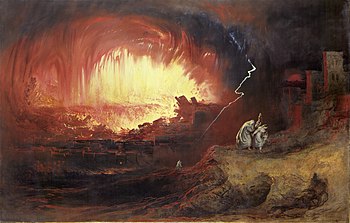Sodom and Gomorrah and same sex sin - homosexuality
 |
| The Destruction Of Sodom And Gomorrah, a painting by John Martin (painter), died 1854, thus 100 years. (Photo credit: Wikipedia) |
Objection Stated
It is highly unlikely that “know” in Genesis 19 means to know sexually or in a homosexual context. The word is used over nine hundred times in the Bible, and it simply does not refer to homosexual activity in any of those instances.
Biblical Response
It is surely true that yada does not refer to sexual activity in the majority of its appearances. Given that the word means both to “know” in the sense of knowing factual information and to “know” intimately in a sexual fashion, one would hardly expect that the discussion of sexual activity would predominate over the discussion of knowing facts, people, or events. Of course the majority of references will be to the more normative use. But does it follow that the term cannot be defined contextually, as it is in Genesis 19? Surely not.
In addition, aside from the clear contextual indication of homosexuality in Genesis 19, such an objection overlooks the situation in Judges 19, which provides a very close parallel to the Sodom story. And while many revisionists dismiss this passage on the same basis as they do the Sodom incident, Judges 19:22–25 only proves the correctness of the interpretation of Sodom and Gomorrah already offered. Note the text of Judges 19:22–25:
22 While they were making merry, behold, the men of the city, certain worthless fellows, surrounded the house, pounding the door; and they spoke to the owner of the house, the old man, saying, “Bring out the man who came into your house that we may have relations with him.”
23 Then the man, the owner of the house, went out to them and said to them, “No, my fellows, please do not act so wickedly; since this man has come into my house, do not commit this act of folly. 24 Here is my virgin daughter and his concubine. Please let me bring them out that you may ravish them and do to them whatever you wish. But do not commit such an act of folly against this man.”
25 But the men would not listen to him. So the man seized his concubine and brought her out to them; and they raped her and abused her all night until morning, then let her go at the approach of dawn.
The Hebrew word yada is used in verse 22, “that we may have relations with him.” Does this merely mean “get to know”? Surely not. In the context this man had sat out in the city square, no one caring about him. Any hospitable person would have had all the opportunity in the world to “get to know” him in that way. No, as the response of the householder shows, theirs was a wicked desire. But just as in Genesis 19, the rest of the story clinches the debate. The very same word is used in verse 25: “and they raped her,” literally, “they knew her.” Yada here is obviously sexual, hence, the use in verse 22 would be in reference to homosexual “knowing.”
White, J. R., & Niell, J. D. (2002). The Same Sex Controversy: Defending and Clarifying the Bible’s Message about Homosexuality (pp. 43–45). Minneapolis, MN: Bethany House Publishers.


